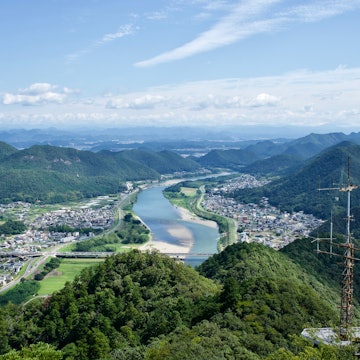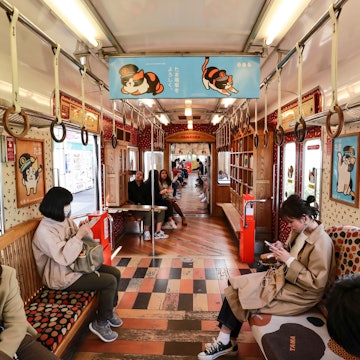
Top 8 day trips from Kyoto for history, culture and nature lovers

Jul 17, 2025 • 9 min read

Within an hour or so from Kyoto, historic castles, beautiful canals, nature and much more awaits. Sanga Park/Shutterstock
Kyoto offers a tantalizing glimpse of ancient Japan – which is why it's one of the most popular destinations in the country. Might we suggest escaping the temple crowds by exploring an alluring spot nearby?
Its position at the heart of the Kansai region makes Kyoto a handy base for hopping on a train to explore fairy-tale castles, go on tasting journeys in matcha towns and float along ancient canals.
Each of these day trips from Kyoto is accessible by train in under two hours. As you plan, keep in mind that if you plan to make several trips within a five-day period, you should consider a Kansai WIDE Area Pass. (All routes are covered by this or a Japan Rail Pass, except in Hiroshima, as noted below.)
These are the most rewarding train trips from Kyoto.
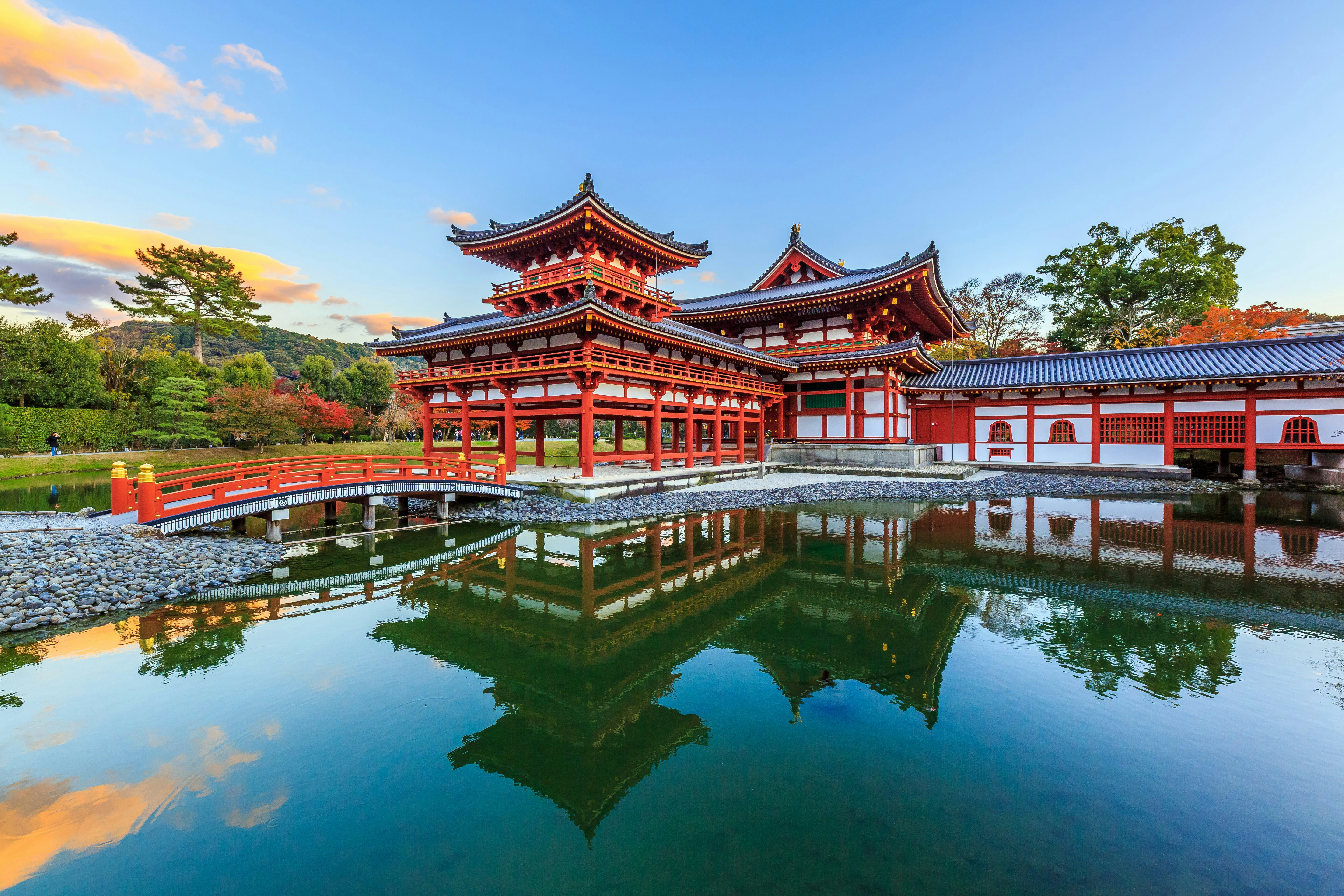
1. What to do in Uji: Kyoto’s matcha capital
Travel time: 20 minutes
How to travel: By train
Mmm…matcha. Green-tea-obsessed Uji lies just next door to Kyoto, yet draws far fewer crowds. Meander along its Omotesando laneway, dipping in and out of charming stores dedicated to selling locally sourced green tea. Pause in cafes to try matcha-flavored treats – ice cream or soba noodles (or both). As you hold up a skewer of dango to the light, you'll first see the scorch marks, then taste them as you chew through the rice-cake balls. The flavors dance between chargrilled, bitter tea and sweet rice.
At the laneway's end, the vermilion Byōdō-in seems to spread its wings and levitate above a green pond (a sight immortalized on the 10-yen coin). The temple's Phoenix Hall is an excellent example of architecture from the Heian Period; after taking in the ambiance, linger in the gardens and delightful tea salon for an hour. If you want more Heian history, explore the on-site Hoshokan Museum to ponder a temple bell and other Buddhist treasures.
Japanese literature enthusiasts should make a visit to the Tale of Genji Museum, dedicated to Murasaki Shikibu's famous 11th-century work (perhaps the world's first-ever novel). The exhibits provide insights into the portion of the narrative that unfolds in Uji.
Cross the Uji River to visit teahouses where artisans demonstrate how to brew the perfect green tea. In summer, finishing the half-day with a cruise in a wooden boat on the river is a pleasant finale indeed – cormorant-fishing demonstrations optional.
How to get to Uji from Kyoto: From Kyoto Station, take the JR Nara line to JR Uji Station.

2. Why visit Nara: temples and friendly deer near Kyoto
Travel time: 1 hour
How to travel: By train
When you come eye to eye with the deer in Nara, you might decide for yourself if, as legend has it, they are divine messengers from the heavens. The 1000-plus placid deer that roam leafy Nara-kōen are an iconic symbol of Japan's first imperial capital. (Feel free to feed the free-roaming deer with crackers sold on-site.) You can take in plenty of Nara's history-rich sights while you're in the park, including the Great Buddha at Tōdai-ji, who is seated with an open hand as tall as a person. Early risers: if you get to Nara by 9am, it's worth observing morning prayers within the splendor of vermilion and cedar shrine pavilions at Kasuga Taisha.
How to get to Nara from Kyoto: From Kyoto Station, take a 55-minute Rapid train on the JR Nara line to Nara Station.

3. Exploring Himeji-jō: Japan’s best preserved castle from Kyoto
Travel time: 55 minutes
How to travel: By train
Tilting your head skywards to be dazzled by the five splendid white stories of Himeji-jō is the stuff of Japanese fairy tales. In fact, the "White Heron" castle has been showcased in movies and TV series aplenty – which is no wonder, given how rare it is to find a truly intact (and not reconstructed) medieval castle in Japan.
Himeji-jō is a stunner, and it's worth visiting early to beat the crowds. Set aside an hour or two to climb to the top for great city views, then to take in the surrounding nine gardens within Kōko-en, designed in Edo Period style. A great time to visit is during cherry blossom season, when everything is framed in pink blooms and petals float atop the moats.
How to get to Himeji-jō from Kyoto: From Kyoto Station, take a JR Hikari train for 55 minutes to Himeji Station.

4. Why Kōbe? For accessibility to nature - and to try wagyū
Travel time: 2 hours
How to travel: By train and bus
Kōbe is Japan's easy and breezy nature city, with countless things to do. Here, the mountains hug the seaport, with great views at every turn that make you stop and smile. Stop to dig into authentic wagyū (Japanese beef) – registered restaurants (identifiable by indoor plaque written in Japanese) are the most reliable. A superb place to start is with the good-value set beef menu at Tor Road Steak Aoyama – or by going all out with an exquisite teppanyaki experience (watching your chef work a hot plate) at Genkichi Kobe Beef. Head uphill from Sannomiya Station to a district of tree-lined streets with merchant houses, quaint cafes and unique shops.
Even with a population of 1.5 million, Kōbe offers easy access to nature. Mt Rokko, a popular hiking spot (accessible by cable car, too), towers over the city's narrow streets and features the landscaped Nunobiki Herb Gardens. Meanwhile, further up, Nunobiki Falls has been a muse for artists, poets and worshippers for centuries.
How to get to Kōbe from Kyoto: From Kyoto Station, take a JR Limited Express Super Hakuto train for 50 minutes to Sannomiya Station. There are two loop buses plying all the sights of the port and city.

5. Discover Kurashiki: Daydream along the canals and wander the laneways
Travel time: 2 hours
How to travel: By train
Willow trees dip into the canals, while handsome black-and-white Edo period (1603–1868) warehouses are tucked away off side lanes. A day trip to Kurashiki is like encountering an outdoor museum. Those buildings – many now converted into denim boutiques, cafes and art workshops – make up the atmospheric Bikan quarter.
Wander the laneways lined with old wooden houses and shops first before popping into the popular Ōhara Museum of Art, which displays works by Picasso, Cézanne and Matisse. Kids will love seeing the exhibits at the Japan Rural Toy Museum, or snacking on a denim-blue ice cream or burger in the Kojima district. (Kurashiki has been jeans-obsessed since its trading-hub days).
A traditional boat tour of Kurashiki Canal is a lovely way to pass the afternoon. On land, Ivy Square is a pretty courtyard that once housed textile factories but now often plays host to live entertainment.
How to get to Kurashiki from Kyoto: Ride the 90-minute Hikari bullet train to Okayama Station, then change to the 15-minute JR Sanyo line train to Kurashiki Station.
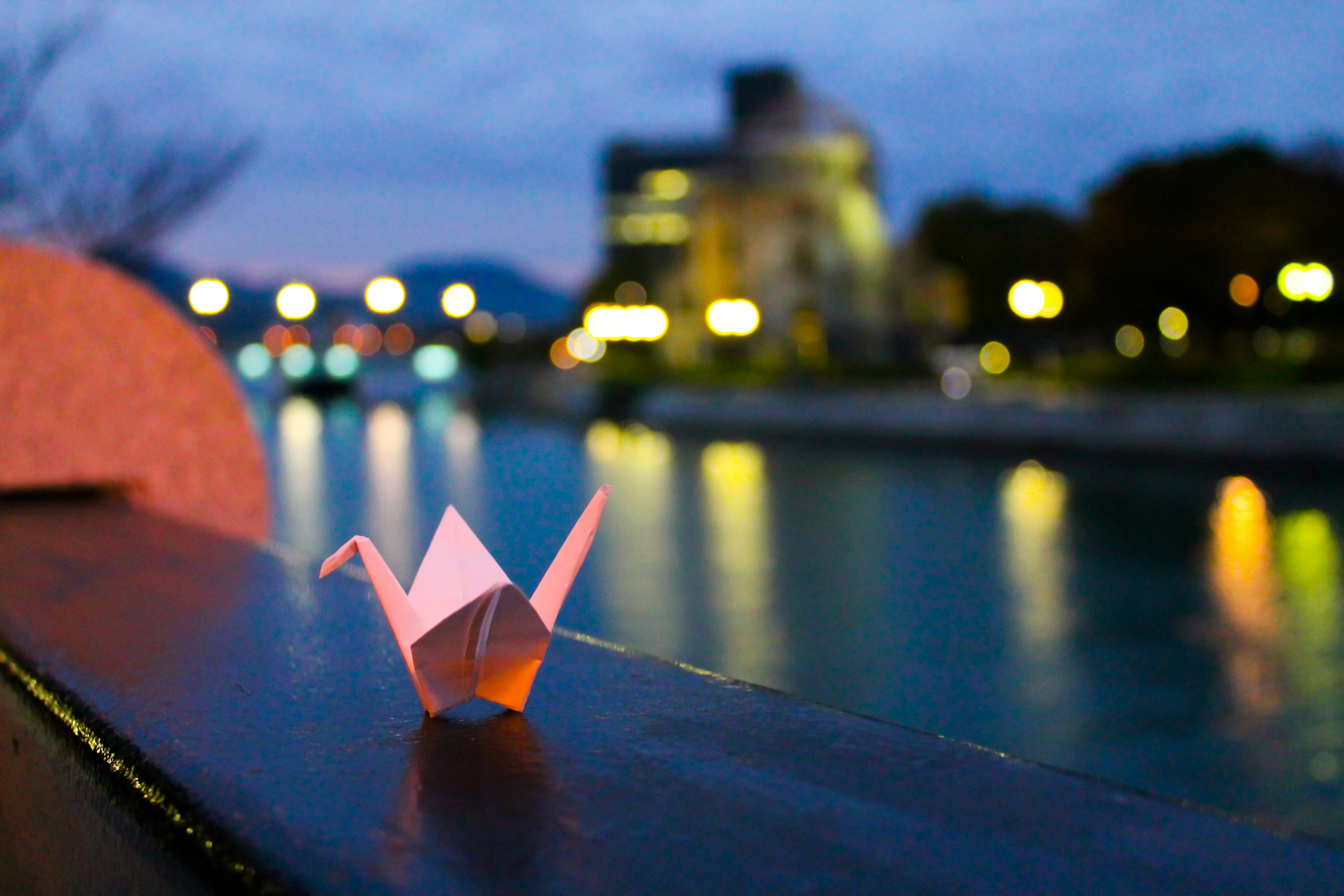
6. Take pause in Hiroshima: visit the peace memorials
Travel time: 2 hours
How to travel: By train
Hiroshima may be synonymous with the devastating atomic bomb attack in 1945. But this leafy, laid-back city has much more to offer visitors these days than just its past. If you want to reflect on the preciousness of peace in the face of war, definitely start at the Peace Memorial Park, then take in the haunting Atomic Bomb Dome, one of very few buildings left standing near the epicenter, whose shell has been preserved as a memorial alongside the Hiroshima Peace Memorial Museum. Seeing the colorful garlands of origami paper cranes sent from schools across the world at the Children's Peace Monument is joyfully moving.
It's ambitious but possible to tackle Hiroshima as a day trip from Kyoto; we'd recommend lingering in the city and staying the night. That way, you can dig into a Hiroshima-style okonomiyaki (savory pancake), which adds a layer of yakisoba noodles for delicious heftiness. A fun way to taste it is by choosing one of the dozens of okonomiyaki restaurants at the multi-level Okonomimura food hall.
Another reason to stay into the late afternoon is the short trip over to the gorgeous island of Miyajima, home to Itsukushima-jinja, a bright red shrine rising out of the ocean – and one of Japan's most iconic views. From here, you can wander through streets lined with machiya (old wooden townhouses) and, if you have another spare hour, take a cable car up to the summit of Mt Misen for breathtaking views of the Seto Inland Sea.
How to get to Hiroshima from Kyoto: From Kyoto Station, take the Shinkansen Nozomi bullet train to Hiroshima (1 hour 40 minutes; this is not covered by JR Pass alone – an additional fee is required). Tourist loop buses and trams depart regularly from Hiroshima Station to the Peace Park. To reach the ferry port from Hiroshima Station, take the JR Sanyo line for 25 minutes to Miyajimaguchi Station.

7. Hungry in Osaka? Taste the sizzle of street food
Travel time: Under 30 minutes
How to travel: By train
Osaka's street-food stalls are a festival of lanterns and delicious, sizzling smells, enjoyable day or night – easily done in a quick jaunt from Kyoto. Since the city is known as "Japan's kitchen," arrive hungry.
Its motto of kuidaore literally means "to eat oneself bankrupt." Which means you can expect to carve up okonomiyaki (savory pancakes) and devour takoyaki (fried octopus balls) along the canal in Dōtombori, peering up to see the iconic Running Man sign. Then try kushikatsu (crumbed meat and vegetables on sticks) near the Tsutenkaku Tower in the kitschy, retro neighborhood of Shin-Sekai.
As you wind through the alleyways of Ura-Namba to Torame Yokacho (Tiger Alley), you can try a range of favorite dishes under one roof. When full, walk off your excesses in the expansive grounds of Osaka Castle or browse boutique and vintage clothing shops in the hip neighborhoods of Amerika-Mura, Horie and Nakazakicho.
How to get to Osaka from Kyoto: From Kyoto Station, take a 28-minute JR Special Rapid train bound for Himeji to Osaka Station. Bullet trains also run between Kyoto and Shin-Osaka Station.
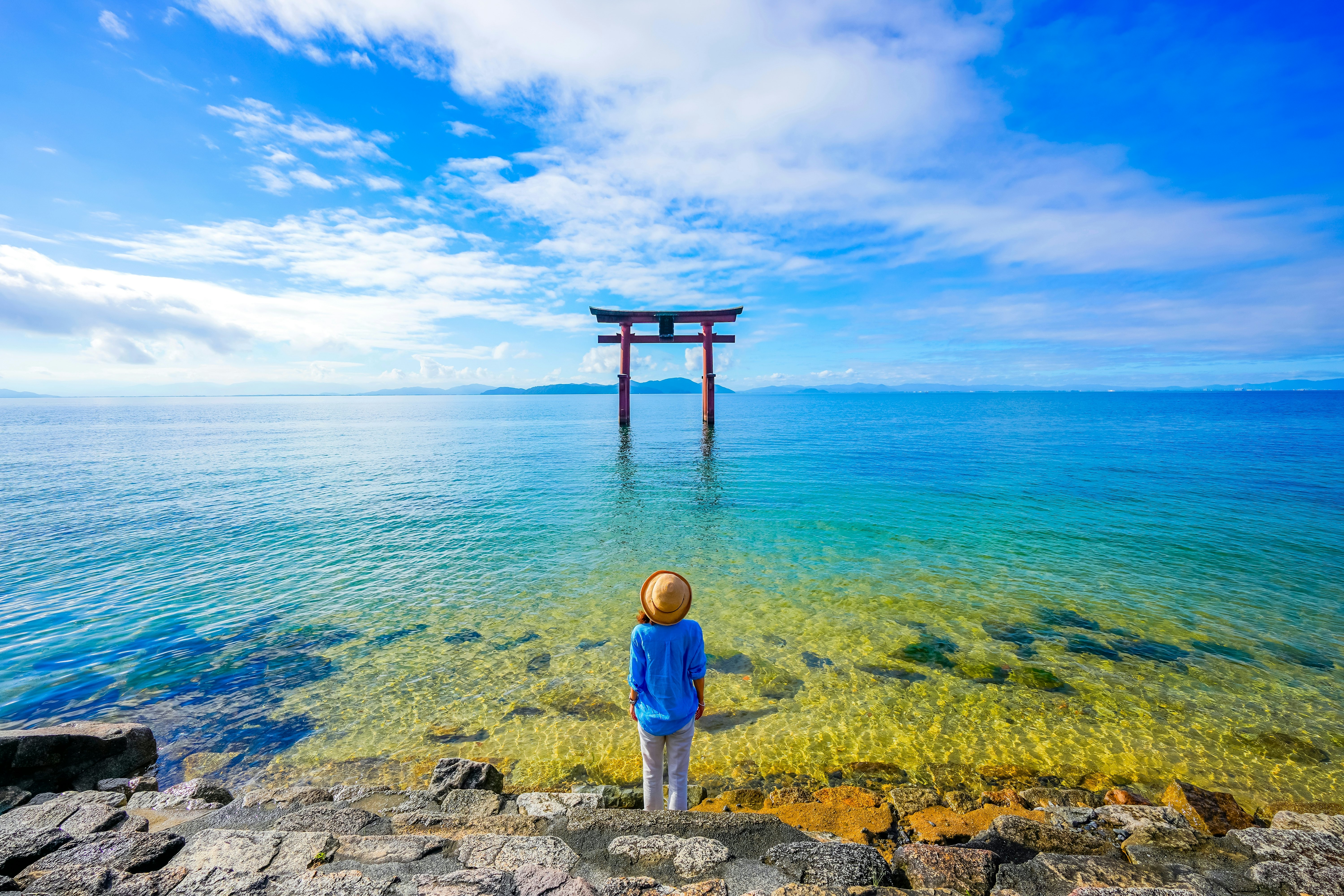
8. Tour Lake Biwa: Cycle, swim, hike and ride canal boats
Travel time: 35 minutes
How to travel: By train
Japan's largest lake is rich with outdoor life. Along its shores, visitors find an almost overwhelming number of temples, castles, cities and activities spread hours apart. Start in the lake's most wonderfully preserved town, Ōmihachiman, far away from foreign crowds. From here, you can rent bicycles and follow the color-coded path markings for straightforward, self-guided cycling on a section around the lake. Or take it slow with a canal boat ride on the narrow waterways, gazing at the feudal-era merchant houses of Ōmihachiman, which once held goods brought across the Sea of Japan.
If you head up the Hachimanyama Ropeway, you'll be rewarded with great views across Lake Biwa, as well as short hiking trails. In summer, listen for the waves pattering the lake shore, inviting you for gentle beach swimming.
With more time, you can chase down the torii (gates) of Shirahige Shrine, which seem to float on the lake, or 17th-century Hikone-jō, shrouded in beautiful autumnal colors in mid- to late-November.
How to get to Lake Biwa from Kyoto: From Kyoto Station, take a Special Rapid train to Omi Hachiman Station.












